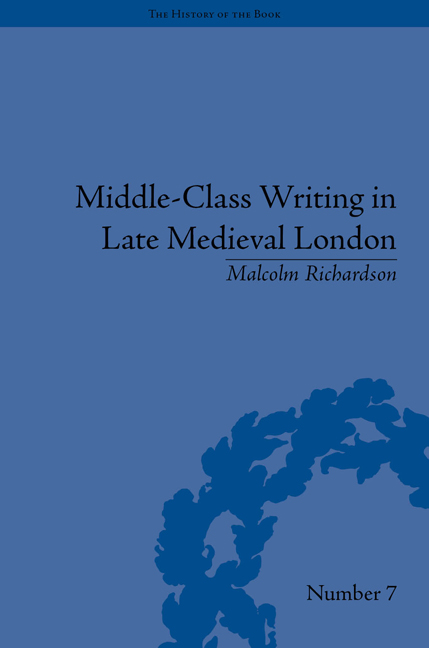Book contents
- Frontmatter
- CONTENTS
- Acknowledgements
- List of Abbreviations
- List of Tables
- Introduction: Pirates and Pens
- 1 London Middle-Class Writing: The Institutional Bases
- 2 ‘An Inextricable Labyrinth’: The Major Genres of Civic Life
- 3 English Middle-Class Writing in the Earlier Fifteenth Century: The Vernacular Letters
- 4 Women's Letters and Men's Books
- Conclusions and Speculations
- Notes
- Works Cited
- Index
1 - London Middle-Class Writing: The Institutional Bases
- Frontmatter
- CONTENTS
- Acknowledgements
- List of Abbreviations
- List of Tables
- Introduction: Pirates and Pens
- 1 London Middle-Class Writing: The Institutional Bases
- 2 ‘An Inextricable Labyrinth’: The Major Genres of Civic Life
- 3 English Middle-Class Writing in the Earlier Fifteenth Century: The Vernacular Letters
- 4 Women's Letters and Men's Books
- Conclusions and Speculations
- Notes
- Works Cited
- Index
Summary
Until Gutenberg invented the printing press in the 1450s, there wasn't much for the average person to read, aside from inscriptions on buildings and coins.
From the curator of an exhibit on ‘Technologies of Writing’ (2006).By 1250, at the latest, the whole of the population was in contact with writings and literate people, whether or not they were personally literate. Even a serf attended a church where a cleric used books and a lord's court which kept written records, including ones related to the serf 's tenancy and duties … English society was collectively literate by the thirteenth century and perhaps much earlier. Everyone knew someone who could read, and everyone's life depended to some extent on reading and writing.
Nicholas Orme, Medieval Children (2001).The quotations above represent bookend views about the familiarity with writing in the later middle Ages. The first, attributed in The Chronicle of Higher Education to a professor of English, represents a now-discredited view, but one still widely held by undergraduates and, apparently, by some of their literature professors. The second quotation is by our leading authority on medieval English education: Professor Orme seems not to be reaching the right audience.
Unknown to our professorial curator, a shift has occurred in the way written language is studied.
- Type
- Chapter
- Information
- Middle-Class Writing in Late Medieval London , pp. 21 - 54Publisher: Pickering & ChattoFirst published in: 2014



